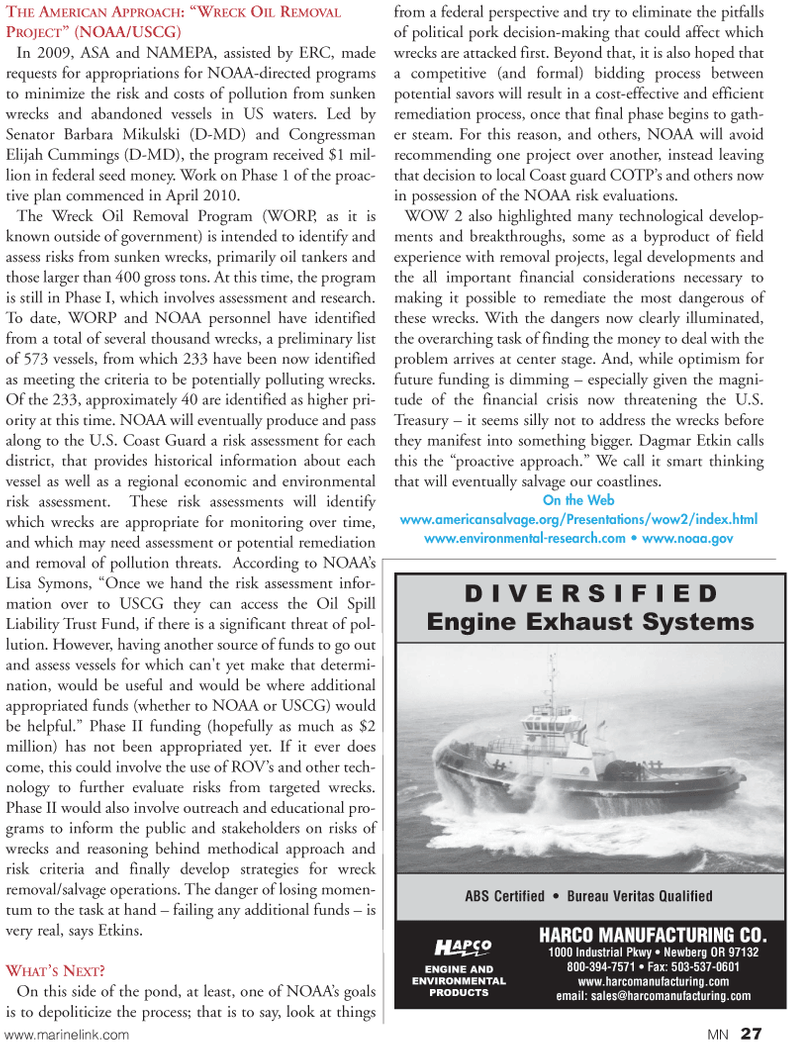
Page 27: of Marine News Magazine (August 2011)
Marine Salvage & Recovery Edition
Read this page in Pdf, Flash or Html5 edition of August 2011 Marine News Magazine
THEAMERICANAPPROACH : W RECKOILREMOVAL PROJECT ? (NOAA/USCG) In 2009, ASA and NAMEPA, assisted by ERC, made requests for appropriations for NOAA-directed programs to minimize the risk and costs of pollution from sunken wrecks and abandoned vessels in US waters. Led by Senator Barbara Mikulski (D-MD) and Congressman Elijah Cummings (D-MD), the program received $1 mil- lion in federal seed money. Work on Phase 1 of the proac- tive plan commenced in April 2010. The Wreck Oil Removal Program (WORP, as it is known outside of government) is intended to identify and assess risks from sunken wrecks, primarily oil tankers and those larger than 400 gross tons. At this time, the program is still in Phase I, which involves assessment and research. To date, WORP and NOAA personnel have identified from a total of several thousand wrecks, a preliminary list of 573 vessels, from which 233 have been now identified as meeting the criteria to be potentially polluting wrecks. Of the 233, approximately 40 are identified as higher pri- ority at this time. NOAA will eventually produce and pass along to the U.S. Coast Guard a risk assessment for each district, that provides historical information about each vessel as well as a regional economic and environmental risk assessment. These risk assessments will identify which wrecks are appropriate for monitoring over time, and which may need assessment or potential remediation and removal of pollution threats. According to NOAAs Lisa Symons, Once we hand the risk assessment infor- mation over to USCG they can access the Oil Spill Liability Trust Fund, if there is a significant threat of pol- lution. However, having another source of funds to go out and assess vessels for which can't yet make that determi- nation, would be useful and would be where additional appropriated funds (whether to NOAA or USCG) would be helpful.? Phase II funding (hopefully as much as $2 million) has not been appropriated yet. If it ever does come, this could involve the use of ROVs and other tech- nology to further evaluate risks from targeted wrecks. Phase II would also involve outreach and educational pro- grams to inform the public and stakeholders on risks ofwrecks and reasoning behind methodical approach and risk criteria and finally develop strategies for wreck removal/salvage operations. The danger of losing momen- tum to the task at hand ? failing any additional funds ? isvery real, says Etkins. WHAT SNEXT ?On this side of the pond, at least, one of NOAAs goals is to depoliticize the process; that is to say, look at things from a federal perspective and try to eliminate the pitfalls of political pork decision-making that could affect which wrecks are attacked first. Beyond that, it is also hoped that a competitive (and formal) bidding process between potential savors will result in a cost-effective and efficient remediation process, once that final phase begins to gath- er steam. For this reason, and others, NOAA will avoid recommending one project over another, instead leaving that decision to local Coast guard COTPs and others now in possession of the NOAA risk evaluations. WOW 2 also highlighted many technological develop- ments and breakthroughs, some as a byproduct of field experience with removal projects, legal developments and the all important financial considerations necessary to making it possible to remediate the most dangerous of these wrecks. With the dangers now clearly illuminated, the overarching task of finding the money to deal with the problem arrives at center stage. And, while optimism for future funding is dimming ? especially given the magni- tude of the financial crisis now threatening the U.S. Treasury ? it seems silly not to address the wrecks before they manifest into something bigger. Dagmar Etkin calls this the proactive approach.? We call it smart thinking that will eventually salvage our coastlines. On the Web www.americansalvage.org/Presentations/wow2/index.html www.environmental-research.com ? www.noaa.gov DIVERSIFIEDEngine Exhaust SystemsHARCO MANUFACTURING CO. 1000 Industrial Pkwy ? Newberg OR 97132800-394-7571 ? Fax: 503-537-0601www.harcomanufacturing.com email: [email protected] AND ENVIRONMENTAL PRODUCTS ABSCertified ? Bureau Veritas Qualified www.marinelink.com MN27

 26
26

 28
28
